
Dimmer
Encyclopedia

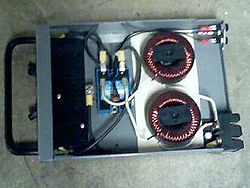
Light fixture
A light fixture, light fitting, or luminaire is an electrical device used to create artificial light and/or illumination, by use of an electric lamp...
. By decreasing or increasing the RMS
Root mean square
In mathematics, the root mean square , also known as the quadratic mean, is a statistical measure of the magnitude of a varying quantity. It is especially useful when variates are positive and negative, e.g., sinusoids...
voltage and, hence, the mean
Arithmetic mean
In mathematics and statistics, the arithmetic mean, often referred to as simply the mean or average when the context is clear, is a method to derive the central tendency of a sample space...
power to the lamp, it is possible to vary the intensity of the light output. Although variable-voltage devices are used for various purposes, the term dimmer is generally reserved for those intended to control resistive incandescent, halogen and more recently compact fluorescent (CFL) lighting. More specialized equipment is needed to dim fluorescent, mercury vapor, solid state
Solid-state lighting
Solid-state lighting refers to a type of lighting that uses semiconductor light-emitting diodes , organic light-emitting diodes , or polymer light-emitting diodes as sources of illumination rather than electrical filaments, plasma , or gas.The term "solid state" refers commonly to light emitted...
and other arc
Arc lamp
"Arc lamp" or "arc light" is the general term for a class of lamps that produce light by an electric arc . The lamp consists of two electrodes, first made from carbon but typically made today of tungsten, which are separated by a gas...
lighting.
Dimmers range in size from small units the size of a normal light switch
Light switch
A light switch is a switch, most commonly used to operate electric lights, permanently connected equipment, or electrical outlets. In torches the switch is often near the bulb, but may be in the tail, or even the entire head itself may constitute the switch .-Wall-mounted switches:Switches for...
used for domestic lighting to high power units used in large theatre
Theatre
Theatre is a collaborative form of fine art that uses live performers to present the experience of a real or imagined event before a live audience in a specific place. The performers may communicate this experience to the audience through combinations of gesture, speech, song, music or dance...
or architectural lighting
Architectural lighting design
Architectural lighting design is a field within architecture and architectural engineering that concerns itself primarily with the illumination of buildings. The objective of architectural lighting design is to obtain sufficient light for the purposes of the building, balancing factors of initial...
installations. Small domestic dimmers are generally directly controlled, although remote control systems (such as X10
X10 (industry standard)
X10 is an international and open industry standard for communication among electronic devices used for home automation, also known as domotics. It primarily uses power line wiring for signaling and control, where the signals involve brief radio frequency bursts representing digital information...
) are available. Modern professional dimmers are generally controlled by a digital control system like DMX or DALI
Digital Addressable Lighting Interface
Digital Addressable Lighting Interface is a technical standard for network-based systems that control lighting in buildings. It was established as a successor for 0-10 V lighting control systems, and as an open standard alternative to Digital Signal Interface , on which it is based...
. In newer systems, these protocols are often used in conjunction with ethernet.
In the professional lighting industry, changes in intensity are called “fades” and can be “fade up” or “fade down”. Dimmers with direct manual control had a limit on the speed they could be varied at but this issue has been largely eliminated with modern digital units (although very fast changes in brightness may still be avoided for other reasons like lamp life).
Modern dimmers are built from silicon-controlled rectifiers (SCR)
Silicon-controlled rectifier
A silicon-controlled rectifier is a four-layer solid state device that controls current. The name "silicon controlled rectifier" or SCR is General Electric's trade name for a type of thyristor. The SCR was developed by a team of power engineers led by Gordon Hall and commercialized by Frank W...
instead of potentiometer
Potentiometer
A potentiometer , informally, a pot, is a three-terminal resistor with a sliding contact that forms an adjustable voltage divider. If only two terminals are used , it acts as a variable resistor or rheostat. Potentiometers are commonly used to control electrical devices such as volume controls on...
s or variable resistors because they have higher efficiency. A variable resistor would dissipate power by heat (efficiency as low as 0.5). By switching on and off, theoretically a silicon-controlled rectifier dimmer does not heat up (efficiency close to 1.0).
History
One of the earliest recorded dimmers is Granville WoodsGranville Woods
Granville T. Woods , was an African-American inventor who held more than 60 patents. Most of his work was on trains and street cars. Woods also invented the Multiplex Telegraph, a device that sent messages between train stations and moving trains. Born in Columbus, Ohio, on April 23, 1856,...
' "Safety Dimmer", published in 1890; dimmers before that were liable to cause fires.
Early dimmers were directly controlled through the manual manipulation of large dimmer panels, but this meant that all power had to come through the lighting control location, which could be inconvenient and potentially dangerous, especially with systems that had a large number of channels, high power lights or both (such as a stage
Stage lighting
Modern stage lighting is a flexible tool in the production of theatre, dance, opera and other performance arts. Several different types of stage lighting instruments are used in the pursuit of the various principles or goals of lighting. Stage lighting has grown considerably in recent years...
disco
Disco
Disco is a genre of dance music. Disco acts charted high during the mid-1970s, and the genre's popularity peaked during the late 1970s. It had its roots in clubs that catered to African American, gay, psychedelic, and other communities in New York City and Philadelphia during the late 1960s and...
or other similar venues).
When thyristor
Thyristor
A thyristor is a solid-state semiconductor device with four layers of alternating N and P-type material. They act as bistable switches, conducting when their gate receives a current trigger, and continue to conduct while they are forward biased .Some sources define silicon controlled rectifiers and...
dimmers came into use, analog remote control systems (often 0-10V lighting control
0-10V lighting control
0-10 V is one of the earliest and simplest electronic lighting control signaling systems; simply put, the control signal is a DC voltage that varies between zero and ten volts. The controlled lighting should scale its output so that at 10 V, the controlled light should be at 100% of its...
systems) became feasible. The wire for the control systems was much smaller (with low current and lower danger) than the heavy power cables of previous lighting systems. Each dimmer had its own control wires which meant a huge number of wires leaving the lighting control location and running to each individual dimmer. Modern systems use a digital control protocol such as DMX512, DALI
Digital Addressable Lighting Interface
Digital Addressable Lighting Interface is a technical standard for network-based systems that control lighting in buildings. It was established as a successor for 0-10 V lighting control systems, and as an open standard alternative to Digital Signal Interface , on which it is based...
, ETCnet, or ETCnet2 to control a large number of dimmers (and other stage equipment) through a single cable.
In 1959, Joel S. Spira, founder of Lutron Electronics Company
Lutron
Lutron Electronics Company, Inc. is a privately held corporation that designs, manufactures, and sells lighting control systems and a variety of other related products...
in 1961, invented the first solid-state dimmer, which switches the current on and off 120 times per second, saving energy and allowing the dimmer to be installed in a standard electrical wallbox.
Saltwater dimmer
Early examples of a dimmer include a salt water dimmer or liquid rheostat. In a salt water dimmer, there were two metal contacts in a glass beaker. One contact was on the bottom, while the other was able to move up and down. The closer the contacts to each other, the higher the level of the light. Using salt water dimmers was a tedious and precarious task that included filling the beakers with water, checking the concentration of the salt, and raising or lowering the top contact. Salt water dimmers were not efficient due to the evaporation of water and the corrosion of the many metal pieces. These dimmers were colloquially known as "piss pots". Many old theatre electricians still recount stories of how they were initiated into the art by being requested to "top up a pot" and receiving a shock, as unbeknownst to them the pot was live.Coil-rotation transformer
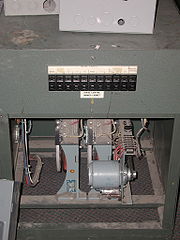
These were often constructed very similar to a standard rotor and stator as in an electric motor, except that the rotor was held against rotation using brakes and was moved to specific positions using high-torque gearing. Because the rotor did not ever turn a complete revolution, a commutator was not required and long flexible cables could be used on the rotor instead.
Rheostat dimmer
Dimmers were also often based on rheostats. These were inefficient; when set to the middle brightness levels, they could dissipate as heat a significant portion of the power rating of the load (up to 25% for resistive loads, more for temperature dependent loads like lamps) so they were physically large and required plenty of cooling air. Also, because their dimming effect depended a great deal on the total load applied to each rheostat, the load needed to be matched fairly carefully to the power rating of the rheostat. Finally, as they relied on mechanical control they were slow and it was difficult to change many channels at a time.Autotransformer dimmer
Variable autotransformerAutotransformer
An autotransformer is an electrical transformer with only one winding. The auto prefix refers to the single coil acting on itself rather than any automatic mechanism. In an autotransformer portions of the same winding act as both the primary and secondary. The winding has at least three taps where...
s (often referred to as variacs) were then introduced. While they were still nearly as large as rheostat dimmers, they were highly efficient devices and their dimming effect was independent of the load applied so it was far easier to design the lighting that would be attached to each autotransformer channel. Remote control of the dimmers was still impractical, although some dimmers were equipped with motor drives that could slowly and steadily reduce or increase the brightness of the attached lamps. Whilst variacs have fallen out of use for lighting they are still used in other applications such as under/overvoltage testing of equipment due to the fact they deliver a reasonably pure sine wave output and produce no radio frequency noise.
Thyristor dimmer

Thyristor
A thyristor is a solid-state semiconductor device with four layers of alternating N and P-type material. They act as bistable switches, conducting when their gate receives a current trigger, and continue to conduct while they are forward biased .Some sources define silicon controlled rectifiers and...
(and briefly, thyratron
Thyratron
A thyratron is a type of gas filled tube used as a high energy electrical switch and controlled rectifier. Triode, tetrode and pentode variations of the thyratron have been manufactured in the past, though most are of the triode design...
) dimmers were introduced to solve some of these problems. Because they use switching techniques instead of potential division, there is almost no wasted power, dimming can be almost instantaneous and is easily controlled by remote electronics. TRIAC
TRIAC
TRIAC, from Triode for Alternating Current, is a genericized tradename for an electronic component that can conduct current in either direction when it is triggered , and is formally called a bidirectional triode thyristor or bilateral triode thyristor.TRIACs belong to the thyristor family and are...
s are used instead of SCR
Silicon-controlled rectifier
A silicon-controlled rectifier is a four-layer solid state device that controls current. The name "silicon controlled rectifier" or SCR is General Electric's trade name for a type of thyristor. The SCR was developed by a team of power engineers led by Gordon Hall and commercialized by Frank W...
thyristors in lower-cost designs but do not have the surge-handling capacity of back-to-back SCRs and are only suitable for loads less than about 20 amps. The switches generate some heat during switching and can cause interference
Electromagnetic interference
Electromagnetic interference is disturbance that affects an electrical circuit due to either electromagnetic induction or electromagnetic radiation emitted from an external source. The disturbance may interrupt, obstruct, or otherwise degrade or limit the effective performance of the circuit...
. Large inductor
Inductor
An inductor is a passive two-terminal electrical component used to store energy in a magnetic field. An inductor's ability to store magnetic energy is measured by its inductance, in units of henries...
s are used as part of the circuitry to suppress this interference. When the dimmer is at 50% power the switches are switching their highest voltage (>300 V in Europe) and the sudden surge of power causes the coils on the inductor to move, creating buzzing sound associated with some types of dimmer; this same effect can be heard in the filaments of the incandescent lamps as "singing". The suppression circuitry adds a lot of weight to the dimmer and is often insufficient to prevent buzzing to be heard on audio systems that share the mains supply with the lighting loads. This development also made it possible to make dimmers small enough to be used in place (within the pattress
Pattress
A pattress or pattress box is the container for the space behind electrical fittings such as power outlet sockets and light switches.A pattress may be made of plastic , or metal...
) of normal domestic light switches. European dimmers must comply with relevant EMC
Electromagnetic compatibility
Electromagnetic compatibility is the branch of electrical sciences which studies the unintentional generation, propagation and reception of electromagnetic energy with reference to the unwanted effects that such energy may induce...
legislation requirements; this involves suppressing the emissions described above to limits described in EN55104.
An alternative to the leading-edge dimming that is typically used with SCRs is trailing edge dimming, where the falling part of the waveform is cut rather than the rising part. This is most often used in devices that use a switched-mode power supplies
Switched-mode power supply
A switched-mode power supply is an electronic power supply that incorporates a switching regulator in order to be highly efficient in the conversion of electrical power...
that need the front of the waveform complete so that it may cut itself.
In the electrical schematic to the right, a typical SCR-based light dimmer dims the light through phase angle control. This unit is wired in series with the load. Diodes (D2, D3, D4 and D5) form a bridge which generates DC with lots of ripple. R and C form a circuit with a time constant, as the voltage increases from zero (at the start of every halfwave) C will charge up, when C is able to make ZD conduct and inject current into the SCR the SCR will fire. When the SCR conducts then D1 will discharge C via the SCR. The SCR will shut off when the current falls to zero when the supply voltage drops at the end of the half cycle, ready for the circuit to start work on the next half cycle.
Sine-wave dimming promises to solve the weight and interference issues that afflict thyristor dimmers. These are effectively high power switched-mode power supplies
Switched-mode power supply
A switched-mode power supply is an electronic power supply that incorporates a switching regulator in order to be highly efficient in the conversion of electrical power...
. They rely on a new generation of insulated-gate bipolar transistors (IGBTs) which are still relatively expensive.
Control
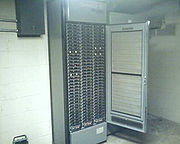
Non domestic dimmers are usually controlled remotely by means of various protocols. Analogue dimmers usually require a separate wire for each channel of dimming carrying a voltage between 0 and 10 V. Some analogue circuitry then derives a control signal from this and the mains supply for the switches. As more channels are added to the system more wires are needed between the lighting controller and the dimmers.
In the late 70s serial analogue protocols were developed. These multiplexed a series of analogue levels onto a single wire, with embedded clocking signal similar to a composite video signal (in the case of Strand Lighting's European D54 standard, handling 384 dimmers) or separate clocking signal (in the case of the US standard AMX192
AMX192
AMX192 is an analog lighting communications protocol used to control stage lighting. It was developed by Strand Century in the late 1970s. Originally, AMX192 was only capable of controlling 192 discrete channels of lighting. Later, multiple AMX192 streams were supported by some lighting desks...
).
Digital protocols, such as DMX512 have proved to be the answer since the late 80s. In early implementations a digital signal was sent from the controller to a demultiplexer, which sat next to the dimmers. This converted the digital signal into a collection of 0 to +10 V or 0 to -10 V signals which could be connected to the individual analogue control circuits.
Modern dimmer designs use microprocessors to convert the digital signal directly into a control signal for the switches. This has many advantages, giving closer control over the dimming, and giving the opportunity for diagnostic feedback to be sent digitally back to the lighting controller.
Patching
Patching is the physical ("hard patch") or virtual ("soft patch") assignment to a circuit or channel for the purpose of control.Hard Patch
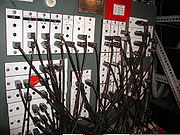

However venues such as theatres demand more flexibility. The lighting rig may change dramatically for each show, and occasionally during shows. In order to deal with these challenges theatres sometimes install circuits run permanently to sockets around the theatre. Instead of these circuits going directly to the dimmer they are connected to a patch bay. A patch bay usually sits next to the dimmers enabling the dimmers to be connected to specific circuits via a patch cable. The patch bay may also enable many circuits to be connected to one dimmer and even series connection for low-voltage lamps. Also in some theatres individual cables are run directly from the light to dimmer. The assigned connections between the circuits (either at the patch bay or in the form of individual cables) and the dimmers is known as the mains or hard patch. Most hard patch situations A control channel on the light board is fixed to a specific dimmer as in a 1-to-1 patch. This is most common in older theatres, and on a tour where dimmers will be brought in by the touring company.
Soft Patch
Most modern fixed installations do not have patch bays, instead they have a dimmer-per-circuit and patch dimmers into channels using a computerised control consoles Soft Patch.Dimming curves
The design of most analogue dimmers meant that the output of the dimmer was not directly proportional to the input. Instead, as the operator brought up a fader, the dimmer would dim slowly at first, then quickly in the middle, then slowly at the top. The shape of the curve resembled that of the third quarter of a sine wave. Different dimmers produced different dimmer curves, and different applications typically demanded different responses.Television often uses a "square law" curve, providing finer control in top part of the curve, essential to allow accurate trimming of the colour temperature of lighting. Theatrical dimmers tend to use a softer "S" or linear curve. Digital dimmers can be made to have whatever curve the manufacturer desires; they may have a choice between a linear relationship and selection of different curves, so that they can be matched with older analogue dimmers. Sophisticated systems provide user-programmable or nonstandard curves, and a common use of a nonstandard curve is to turn a dimmer into a "non-dim", switching on at a user defined control level.

Preheat
Some types of incandescent (filament) lamps should not be switched to full power from cold, and doing so can shorten their life dramatically owing to the large inrush currentInrush current
Inrush current, input surge current or switch-on surge refers to the maximum, instantaneous input current drawn by an electrical device when first turned on. For example, incandescent light bulbs have high inrush currents until their filaments warm up and their resistance increases...
that occurs. To soften the blow to the lamps slightly, dimmers may have a preheat function. This sets a minimum level, usually between 5% and 10%, which appears turned-off to the audience, but stops the lamp from cooling down too much. This also speeds up the lamp's reaction to sudden bursts of power that operators of rock'n'roll-style shows appreciate. The opposite of this function is sometimes called top-set. This limits the maximum power supplied to a lamp, which can also extend its life.
In less advanced systems, this same effect is achieved by literally pre-heating (warming) the globes before an event or performance. This is usually achieved by slowly bringing the lights up to full (or usually 90-95%) power over a period of between 1/2 to 1 hour. This is as effective as a built in preheat function.
The digital revolution
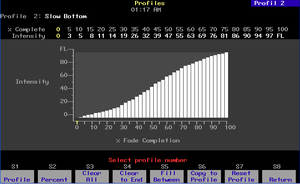
Modern digital desks can emulate preheat and dimmer curves and allow a soft patch to be done in memory. This is often preferred as it means that the dimmer rack can be exchanged for another one without having to transfer complicated settings. Many different curves, or profiles can be programmed and used on different channels.
Rise time
One measure of the quality of the dimmer is the "rise time". The rise time in this context is the amount of time it takes within the cut part of the waveform to get from the zero-point crossover to the start of the uncut part of the waveform. A longer rise time reduces the noise of the dimmer and the lamp as well as extending the life of the lamp. Unsurprisingly, a longer rise time is more expensive to implement than a short one, this is because the size of choke has to be increased.See also
- ChokeChoke (electronics)A choke is a coil of insulated wire, often wound on a magnetic core, used as a passive inductor which blocks higher-frequency alternating current in an electrical circuit while passing signals of much lower frequency and direct current by having an impedance largely determined by reactance, which...
- DeratingDeratingDerating is the operation of a machine at less than its rated maximum power in order to prolong its life. The term is commonly applied to electrical and electronic devices and to internal combustion engines.-In electronics:...
- Fluorescent lampFluorescent lampA fluorescent lamp or fluorescent tube is a gas-discharge lamp that uses electricity to excite mercury vapor. The excited mercury atoms produce short-wave ultraviolet light that then causes a phosphor to fluoresce, producing visible light. A fluorescent lamp converts electrical power into useful...
- GangingGangingGanging is two or more electrical controls mounted side by side in a series of connected wallboxes....
- Heat sinkHeat sinkA heat sink is a term for a component or assembly that transfers heat generated within a solid material to a fluid medium, such as air or a liquid. Examples of heat sinks are the heat exchangers used in refrigeration and air conditioning systems and the radiator in a car...
- Incandescent light bulbIncandescent light bulbThe incandescent light bulb, incandescent lamp or incandescent light globe makes light by heating a metal filament wire to a high temperature until it glows. The hot filament is protected from air by a glass bulb that is filled with inert gas or evacuated. In a halogen lamp, a chemical process...
- Infinite switchInfinite switchAn infinite switch is a type of switch that allows variable power output and is so called because its average output is infinitely variable rather than being limited to a few switched levels. They utilize a bi-metallic strip conductive connection across terminals that disconnects with increased...
- Lighting control consoleLighting control consoleA lighting control console is an electronic device used in theatrical lighting design to control multiple lights at once...
- PotentiometerPotentiometerA potentiometer , informally, a pot, is a three-terminal resistor with a sliding contact that forms an adjustable voltage divider. If only two terminals are used , it acts as a variable resistor or rheostat. Potentiometers are commonly used to control electrical devices such as volume controls on...
- TRIACTRIACTRIAC, from Triode for Alternating Current, is a genericized tradename for an electronic component that can conduct current in either direction when it is triggered , and is formally called a bidirectional triode thyristor or bilateral triode thyristor.TRIACs belong to the thyristor family and are...
- CompuliteCompuliteCompulite is an Israel based company that designs and builds lighting control console, dimmers and other theatre lighting related equipment.The company was founded in 1978 by Dan Redler and Alfred Senator....
- Electronic Theatre ControlsElectronic Theatre ControlsElectronic Theatre Controls is a privately held corporation with global headquarters in Middleton, Wisconsin, United States. An international manufacturer of entertainment and architectural lighting systems, ETC offers professional lighting fixtures, lighting control consoles, dimming equipment...
- Home automationHome automationHome automation is the residential extension of "building automation". It is automation of the home, housework or household activity. Home automation may include centralized control of lighting, HVAC , appliances, and other systems, to provide improved convenience, comfort, energy efficiency and...

